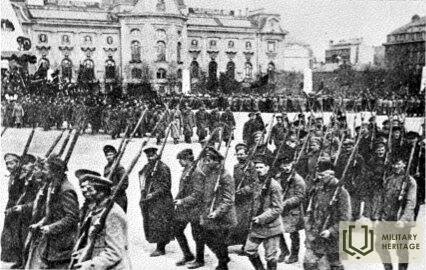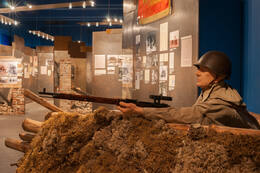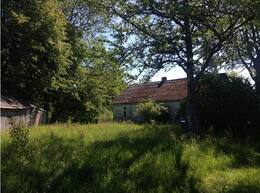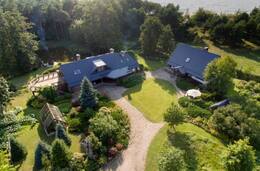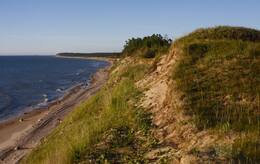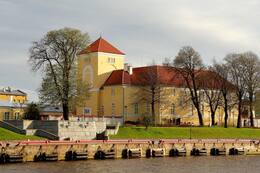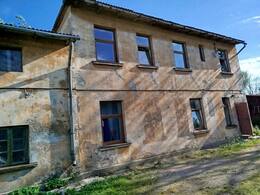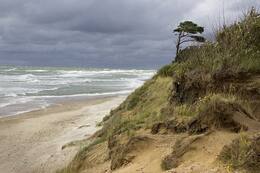The Red Army occupies Riga I Wars of Independence
By the end of December 1918, the Red Army had approached Riga from the north, east and south. From Cēsis, the 2nd Latvian Rifle Brigade regiments were advancing towards Riga, while along both banks of the Daugava – the 1st Latvian Rifle Brigade and the Russian 2nd Novgorod Rifle Division regiments. The last unsuccessful attempt to stop the Red Army on the outskirts of Riga took place at the turn of the year near Inčukalns. Here, the Landeswehr company, together with the Iron Brigade (this was the designation of the German army units that agreed to fight against the Bolsheviks) and Russian anti-Bolshevik units, suffered a heavy defeat in two days of battles in a battle with the 1st and 4th Latvian Rifle Regiments.
With hopes of stopping the approach of the Red Army and its “red” Latvian riflemen fading, the Provisional Government led by K. Ulmanis, accompanied by the Student Company, left Riga at noon on January 2, 1919. On the morning of January 3, the remaining national military units loyal to the government also left the city, a total of about 400 soldiers under the command of Colonel Oskars Kalpaks. Most of the newly formed national army deserted because they did not want to fight against the “red” Latvian riflemen. The calculation of the Russian communists, involving the regiments of the Latvian Soviet Rifle Division in the invasion of the Baltics, had been completely justified. English warships and several thousand refugees also left the city.
On the night of January 2, an armed uprising of the Bolsheviks began in Riga. All night and on January 3, chaotic clashes took place in the city between Bolshevik fighters, gangs of robbers and units of anti-Bolshevik forces that remained in the city. The guards of the city prisons had escaped and hundreds of prisoners were released (600 people from the Termincietums prison alone). In clashes with the Iron Brigade and some Landeswehr units near the Riga railway station, the elevator and the Second City Theatre (now the Latvian National Theatre), 22 people died.
On the afternoon of January 3, 1919, the first rifle cavalry reconnaissance groups entered Riga. In the afternoon and evening, the 6th Latvian Rifle Regiment, transferred from Valka, entered the city. On the night of January 4, the Provisional Soviet Government led by Pēteris Stučka arrived by train to the destroyed Jugla Bridge. Its members transferred to an armored train seized from the Germans and entered Riga at night. As early as three in the morning, representatives of the Soviet Government participated in a meeting of the Riga War Revolutionary Committee, which was the leader of the Bolshevik-led uprising. The Bolshevik rule in Riga, which lasted less than five months, began.
More information sources
Blizzard of Souls. The “Red” Riflemen Enter Riga. Available: https://www.dveseluputenis.lv/lv/laika-skala/notikums/106/sarkanie-strelnieki-ieiet-riga/ [accessed 06.05.2021].
Related timeline
Related objects
Monument to the first battle for Latvia's independence
Located in Inčukalns, Atmodas Street 2.
On July 3, 2016, a monument to the first battle for Latvian independence was unveiled, dedicated to the Latvian Landeswehr (Die Lettländische Landeswehr), in which local Baltic Germans, Russians and Latvians, who were in units on both sides at the time, defended the newly founded state against the Bolshevik Red Army. Eižens Upmanis, the chairman of the Brothers' Graves Committee, concluded at the time that this could be the first monument to the combined Latvian and Baltic German forces in battle memorials outside the cemeteries. At that time, Lieutenant Colonel Oskars Kalpaks was appointed commander of the Latvian units of the Latvian Landeswehr, from whose units the later Latvian Army grew and formed during the Freedom Struggle.
In 1918, the entire territory of present-day Latvia had fallen into the hands of the German Empire and its troops. However, in the late summer and autumn of 1918, the situation began to rapidly turn against Germany and it was clear that it was only a matter of time before Germany would be forced to admit defeat in World War I. The Russian Empire, which Latvia was part of until World War I, had ceased to exist earlier, with the February and October revolutions of 1917. On 18 November 1918, the Republic of Latvia was proclaimed. The German army, which was located in the territory of Latvia, after the armistice with the Entente powers on 11 November 1918, was no longer motivated for further hostilities and most of its soldiers simply wanted to return to their homeland.
Under such circumstances, it was clear that the defense of Latvia depended primarily on a national guard formed by the Latvian population itself. Initially, due to their education and relatively greater ability to self-organize, the Baltic Germans living in Latvia showed the greatest initiative in forming such a national guard. Russian soldiers also joined the national guard. In order to ensure the supply of the national guard with uniforms, weapons and other necessary resources, the Latvian Provisional Government concluded an agreement with the German representative Augustus Vinnig on December 7, 1918, providing for the provision of the national guard from the German army reserves located in the territory of Latvia. This agreement indicated, among other things, that this national guard, with the official name “Latvijas zemessardze” or in German – “die Lettländische Landeswehr”, would be the armed forces of the Republic of Latvia.
The Latvian National Guard was confronted by two Latvian Red Riflemen regiments (i.e., approximately 2,000–3,000 soldiers) that had previously been experienced in World War I and the Russian Civil War. Despite the Red Army's experience and numerical superiority, the Latvian National Guard held Inčukalna in fierce battles for two days, until finally, on the evening of January 1, 1919, in order to avoid encirclement, it was forced to retreat, losing 43 killed and several wounded, most of whom were captured by the Bolsheviks, where they were killed or died of hunger or disease.
Author: Artis Buks. Material: Fieldstone. The monument is made of a large monolithic stone that was found in Ruļļi near Jelgava.
Latvian War Museum
The Latvian War Museum is located in the Old Town not far from the Freedom Monument in a historic defence building called the ‘Powder Tower’. There are 11 exhibits in the museum. There are various weapons, documents, uniforms, awards, badges and other items detailing the everyday life of a soldier in war. The Latvian War Museum is one of the oldest museums in Latvia. Its origins can be found in World War I. Museum’s collection was made up mainly of personal items of soldiers or items found on battlefields. After Latvia gained its independence the main goal of the museum became to create an exposition on the military history of Latvia and the active role of the population in protecting their land. In 1937 the museum was expanded and was technically one of the most modern museums in Europe at that time. The Powder Tower was one of the fortification towers of Riga. Some evidence dates back to 1330 where it has been mentioned as the ‘Sand Tower’. The tower was destroyed in 1621 when Riga was besieged by the Swedish Army. But in 1650 a new tower for storing gunpowder and weapons was built. After the city’s fortifications were taken down, the Powder Tower remains as one of the most important pieces of evidence of the Riga defence system.
"Laukgaļi" houses, the residence of the writer Kārlis Skalbe
“Laukgaļi” in Jūrkalne parish, the place where writer Kārlis Skalbe stayed in October - November 1944, while waiting for a refugee boat to Sweden.
Writer Kārlis Skalbe (1879–1945) was a member of the Latvian Provisional National Council and the Latvian People's Council, a deputy of the Constitutional Assembly of the Republic of Latvia and the 1st and 4th Saeima. During the German occupation, he was the editor-in-chief of the literary magazine "Latvju Mēnešraksts", one of the signatories of the LCP memorandum of March 17, 1944.
On November 11, 1944, she fled to Sweden. She died in 1945 in Stockholm.
"Bambaļi" houses - one of the main accommodation places for boat refugees
The restored “Bambaļi” houses in Ošvalki, Jūrkalne parish, which in 1944 was one of the main places of accommodation for boat refugees on the Kurzeme coast.
Memories of boat refugee Kārlis Draviņš: ““Bambaļi” were old, small, very run-down houses in Jūrkalne parish, about 40 kilometers from Ventspils. [..] Small fields spread around in a damp place, but on the other side an old, overgrown dune wrapped itself around it. The sea gurgled a little behind it - the houses were right next to the sea. On the other side, half a kilometer away, the Pāvilosta-Užava highway ran, but the road to the houses was not easy to drive on, which is why the Germans could not be everyday guests here. The place where boats were waiting was easily accessible - a small forest clearing on a high bank. [..]
The owner of "Bambaļi" and her group, who were also waiting for the "movement of the water", lived in two rooms facing the sea, but the group of refugees lived at the other end of the house, also in two rooms. They shared the kitchen. The hallway between the two ends was stuffed with the refugees' many belongings. The rooms were filled with straw, which was spread out along the walls. On each side of the room was one bed, where a mother and her children slept. The straw beds were covered with sheets or something else during the day. They came out to sit or sleep in them during the day, because there was nowhere else to stay. [..] The days passed monotonously, one after the other. They got up on command, there was no hurry. When the communal breakfast was eaten, some went to play cards, some took up fortune-telling, while others tried to read. Some had to do household chores - fetch firewood, water.
Temporary refugee shelters "Vārves būda"
"Vārves būdas", a place in Ventspils municipality that served as temporary housing for Latvian refugees who were waiting for boats from Gotland to arrive in 1944.
Memories of the boatman V. Jurjaks:
“My half-brother and his family had come to us from Riga, and when the news came that a boat was expected at Vārve, I united these people of mine with the group of police chief Jasūnas and we all set out for Vārve. We waited for the signals until late at night, but the boat did not arrive. We waited there like that for a whole week. It started to rain. People made tents out of sheets, so we called this place “Vārve huts”. My wife and I spent more time in Ventspils during the day, and eventually we had to think about how to deliver food to those waiting. I remember one night my wife and I were carrying hot boiled potatoes through the forest for them on our bicycles. It was raining heavily, lightning was roaring, and the warm potatoes tasted good to the waiting people who had spilled out. The Vārve forester had accidentally discovered this hiding place, but - promising him the possibility of a transfer, he came to help. The Germans had begun to go through the houses of the coastal residents, looking for people in the years of conscription. Two young people had been caught in the forest near the “Vārve huts”. Therefore, this place could no longer be safe for these more than fifty people who were languishing here.
Prison in the Livonian Order Castle during World War II
Several members of the LCP Ventspils communications group and refugee boat operators were detained in the prison established in the Livonian Order Castle in 1944-1945.
Memories of the boatman Žanis Fonzovs: “Two boats left Sweden - “Krīvs” and “Zvejnieks”. I was on “Zvejnieks”, and the crew included Saulīte and Grunti. [..] The weather was beautiful, I was sailing so inconspicuously, not very high. I immediately saw - I was in Morse code. The boat was approaching. I went down to the engine room, because in addition to Saulīte's papers, I also had letters from the arrivals to relatives in Latvia and the collected weapons in a bag. I threw the letters and papers into that bag of weapons and everything overboard.. What then! The boat approached ours and the Germans asked for our driving permits. [..] So on October 21, the Germans took us with the entire “Zvejnieks” to Ventspils. They took us to prison. There were about 30 people in the room. I had a sheepskin coat on my back, I put it on the floor and put it on myself, but I had not slept last night. On the second or third day, they called us out for questioning. We had agreed to say that we were refugees on our way to Germany. I had just wanted to go to Lielirbe to follow my friend. It seems that they believed us then. [..] But then the situation in Ventspils changed: the city was taken over by the military administration, and we were called in for questioning a second time. It was worse, because they showed us a box of Swedish matches and a piece of kroon that were allegedly found on the boat. One of the interrogators was a Latvian, and he even beheaded us for telling the whole truth. We saw that the fairy tale had ended, we simply had to confess.
The building in Ventspils where LCP liaison Valentine Jaunzeme (Lasmane) lived in 1944
The house at Lauku Street 4, Ventspils, was home to the teacher Valentīne Lasmane (nee Jaunzeme) (1916–2018). She was a liaison officer for the Latvian Communist Party and a member of the Ventspils liaison group. After World War II, she lived in Sweden.
She compiled the testimonies of 130 boat refugees in the publication “Across the Sea 1944/1945” (Stockholm, 1990), but V. Lasmane's own life story can be read in the book “Night is No Longer Just for Sleeping” (Riga, 2020). In 2000, she was awarded the Order of the Three Stars. She died at the age of 102 in 2018 in the Stockholm suburb of Täby.
The steep bank of Staldzene, from which refugee boat traffic to Sweden took place in 1944
In 1944, there was active refugee boat traffic from the Staldzene cliffs to the shores of Sweden.
Ž. Lapuķis' memories of meeting with Dr. E. Bakusis:
“One afternoon, a local police officer came to me and quietly told me that a boat from Sweden was expected to arrive that night near the village of Staldzene near the Koku hills to pick up refugees. My task was to come with a group of guards from my unit to guard this place and, if necessary, help to transport the refugees to the motorboat. [..] Not far from the sea, without waiting, a man stood in front of us on the rope, wearing a gray half-coat with a turned-up collar and a jockey's hat pulled low on his forehead. He said a quiet good evening and asked: “Is this the road to Lošupi?” That was the watchword for Swedish riders in that place. He said that he was here on a special mission, but at the same time he would like to get his family to Sweden safely. Then, to my great surprise, he pulled out our forestry plan from his pocket. In the twilight, I began to watch the stranger's face and soon recognized him. It was Bakūzis, the head of the Forestry Department's Forestry Management Division [..] It was approaching midnight when we saw a black dot in the distance in the sea. We gave the agreed signal with a flashlight, repeating it several times. After a short while, the same answer came from the black dot, only it was not from a flashlight, but the light transmission of a warship. We realized that the boat was no longer expected that night and the group of refugees was starting to disperse. Bakūzis invited us both with the company commander to stay with his family. We found it in a hollow in the dunes under a thick fir tree. There, in the green moss, with their heads resting on a white pillow, three offspring of this family were lying in a deep sleep, and next to them, with a white scarf around their heads, sat the caring mother of the house. The father of the house found a bottle and the mother of the house offered sandwiches. It seemed that with their Latvian sincerity they were the real father and mother of the house, who had found their home on this rainy autumn night under the fir tree of their homeland. On one side the sea hisses, on the other a forest massif and heavy raindrops slowly fall through the branches of the fir tree. We emptied the bottle, but refused the sandwiches, because we realized that they needed them more themselves.
The Mazirbe coast, from where refugee boat traffic to Sweden took place in 1944
The Mazirbe coast was an important place during World War II, from where refugee boat traffic to Sweden took place in 1944.
Memories of boat refugee Ilona Cīrule (nee Mālītis): “I was 13 years old at the time. I remember that at the end of September we traveled in a caravan from Riga to Mazirbe for a whole week. The trip remains in my memory as something unpleasant: the Russian candles in the sky worried me to the core. We lived in Mazirbe for about three weeks, and every day I heard talk about crossing over and about looking for boats. Finally, on October 21, we had to get ready. [..] There were about 90 of us on the boat. I sat on my father’s lap on the deck. The small children with their mothers were below, and they were short of air. I must have been dozing, but in the morning of the next day a plane was spotted and a ship on the horizon. Then the people became quiet. In the afternoon, the ship came again, and this time it came right at us. But it happened like in a fairy tale: it was a Swedish military ship! They pulled us all onto the ship, gave us warm cocoa and took us to the port of Nynashamn. Our boat was tied to the ship and its owner Zariņš-Petravs received it safe and sound. Among the guests were Šici, Zanderi, Vanagi, the former Minister of Justice Mrs. Apsīša, our family and others. I know that the boat had to be paid in gold. But how much - I don't know.
Related stories
Bombing of Rezekne in 1944
The bombing of Rēzekne took place on Easter 1944, and as a result, a large part of the city's buildings were destroyed and dozens of civilians were killed, while thousands more were left homeless. The people who experienced these events firsthand and can tell us about them were only children at the time. The author of this story is one of them.
Saving the bridge over the Nega River from being blown up
During the German retreat in 1944, many important objects were blown up and it was very difficult to prevent this, however, there are also stories about miraculous incidents when the courage of local residents and the tolerance of a soldier allow places that are important to the locals to be saved, and the salmon survived. One of the stories is this one about a discussion between a housewife and a German soldier that saved an entire bridge from being blown up.
Efforts to prevent the explosion of the Ķegums HPP
During World War II, when the armies retreated, a large number of militarily and logistically important facilities in Latvia were blown up so that these resources would not be left for the enemy. Such facilities were also in the vicinity of Ķegums, where one of the most important facilities is the Ķegums HPP, which, thanks to the efforts and efforts of its employees, was not completely destroyed.




